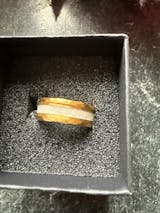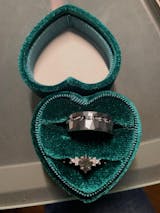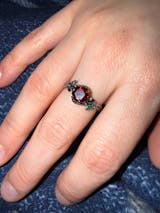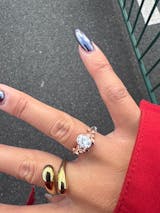Lapis Lazuli vs Turquoise

Lapis Lazuli vs. Turquoise: The Ultimate Guide to Ancient Blue Treasures
Have you ever wondered why ancient pharaohs and Native American chiefs both treasured blue gemstones? Lapis lazuli and turquoise have captivated civilizations for thousands of years. These stunning blue stones continue to enchant jewelry lovers today. But which one should you choose?
This complete guide reveals everything you need to know about these two remarkable gems. We'll explore their differences, similarities, and help you decide which stone fits your style and budget. Whether you're shopping for your first piece or expanding your collection, you'll discover the secrets that make each stone special.
Let's dive into the fascinating world of blue gemstones!

Quick Comparison: Lapis Lazuli vs. Turquoise at a Glance
|
Feature |
Lapis Lazuli |
Turquoise |
|
Color |
Deep blue with gold flecks |
Sky blue to blue-green |
|
Hardness |
5-5.5 (Mohs scale) |
5-6 (Mohs scale) |
|
Composition |
Lazurite, calcite, pyrite |
Copper aluminum phosphate |
|
Price Range |
$1-$200 per carat |
$1-$1,000+ per carat |
|
Best Known For |
Golden pyrite sparkles |
Matrix patterns |
|
Origin |
Afghanistan (premium) |
Arizona, Nevada (USA) |
|
Cultural Significance |
Ancient Egypt, royalty |
Native American traditions |
|
Chakra Connection |
Third eye, throat |
Throat chakra |
|
Care Level |
Moderate (avoid heat/acids) |
High (porous, needs care) |
|
Best Settings |
Gold, silver equally |
Silver (traditional) |
Understanding the Physical Properties
Lapis Lazuli Characteristics
What makes lapis lazuli so special? This royal blue gemstone isn't actually a single mineral. It's a rock made up of several minerals working together:
- Lazurite (25-40%): Gives the deep blue color
- Calcite: Creates white streaks and patches
- Pyrite: Adds those famous golden sparkles
The hardness ranges from 5 to 5.5 on the Mohs scale. This means it's softer than quartz but harder than your fingernail. You can scratch it with a steel knife, but not with a copper coin.
Quality indicators include:
- Rich, saturated blue color (not too light or dark)
- Minimal white calcite streaks
- Fine golden pyrite flecks (not too much!)
- Even color distribution

Turquoise Characteristics
Turquoise tells a different story. Its chemical formula is CuAl₆(PO₄)₄(OH)₈·4H₂O - basically copper aluminum phosphate with water. The copper gives turquoise its beautiful blue color.
Key features:
- Hardness: 5-6 on the Mohs scale (slightly harder than lapis)
- Porosity: Very porous (absorbs oils and moisture easily)
- Color range: Sky blue to blue-green to green
- Matrix patterns: Host rock creates unique web-like designs
What affects turquoise quality?
- Color intensity and stability
- Matrix patterns (some are highly prized!)
- Natural vs. stabilized treatments
- Origin and rarity

How to Tell Them Apart
Struggling to identify which stone you have? Here are foolproof methods:
Visual Clues:
- Lapis: Deep blue with gold sparkles (pyrite)
- Turquoise: Lighter blue with dark matrix lines
Simple Tests:
1. The Pyrite Test: Only lapis has golden metallic flecks
2. The Matrix Test: Turquoise shows web-like host rock patterns
3. The Color Test: Lapis is typically darker and more uniform
Professional tip: When in doubt, visit a certified gemologist. Photos can be deceiving!
Origins and Mining Locations
Lapis Lazuli Sources
Afghanistan remains the king of lapis lazuli. The Sar-e-Sang mine in Badakhshan province has produced the world's finest lapis for over 6,000 years. This is where the deep, royal blue stones with perfect golden pyrite come from.
Other important sources:
- Chile: Produces lighter blue varieties
- Russia: Siberian deposits with unique characteristics
- Pakistan: Good quality but different from Afghan material
Why is Afghan lapis so special? The geological conditions create that perfect balance of deep blue lazurite with just enough pyrite sparkles. It's like nature's recipe for perfection!
Turquoise Mining Regions
The American Southwest is turquoise country! Arizona and Nevada produce some of the world's most famous varieties:
Famous American Mines:
- Sleeping Beauty (Arizona): Pure sky blue, minimal matrix
- Kingman (Arizona): Light blue with beautiful matrix
- Royston (Nevada): Green to blue with stunning patterns
- Carico Lake (Nevada): Bright lime green variety
International Sources:
- Iran: Historic Persian turquoise (robin's egg blue)
- Tibet: Sacred stones used in traditional jewelry
- China: Various qualities and colors
Sadly, many famous mines have closed. The Sleeping Beauty mine shut down in 2012, making its turquoise increasingly valuable. This is why knowing your turquoise source matters for both value and authenticity.
Historical and Cultural Significance
Lapis Lazuli Through History
Imagine King Tutankhamun's death mask - that brilliant blue comes from lapis lazuli! Ancient Egyptians believed this stone connected them to the heavens. They ground it into powder for eye makeup and used whole stones for amulets.

Renaissance artists treasured lapis for creating ultramarine pigment. This blue was more expensive than gold! Artists like Vermeer used it sparingly, reserving it for the Virgin Mary's robes in their paintings.
Modern significance:
- Symbol of truth and wisdom
- Stone of royalty and nobility
- Used in meditation and spiritual practices
- Popular in contemporary jewelry design
Turquoise Cultural Heritage
For Native Americans, turquoise is sacred. It represents protection, healing, and connection to nature. Many tribes believe turquoise can change color to warn of danger or illness.

Cultural traditions:
- Navajo: Babies receive turquoise beads for protection
- Pueblo: Used in ceremonial jewelry and art
- Zuni: Master craftsmen create intricate inlay work
- Hopi: Symbol of rain and sky blessings
Persian culture also reveres turquoise. They believe it protects against the evil eye and brings good fortune. The word "turquoise" comes from "Turkish stone" because trade routes brought Persian turquoise through Turkey to Europe.
Metaphysical and Healing Properties
Lapis Lazuli Spiritual Attributes
Are you seeking wisdom and truth? Lapis lazuli is known as the stone of enlightenment. It's connected to the third eye chakra, which governs intuition and inner wisdom.
Believed benefits:
- Enhances communication and self-expression
- Promotes mental clarity and focus
- Supports meditation and spiritual growth
- Helps with honest self-reflection
- Encourages leadership qualities
How to use lapis for spiritual work:
Place on your forehead during meditation
Wear as jewelry for daily wisdom
Keep in your workspace for clear thinking
Use in crystal healing layouts
Turquoise Energy Properties
Turquoise connects to the throat chakra, supporting communication and creativity. Many believe it offers protection during travel and promotes emotional healing.
Traditional healing properties:
- Protects against negative energy
- Supports emotional balance
- Enhances communication skills
- Promotes self-forgiveness
- Aids in creative expression
Scientific perspective: While these properties aren't scientifically proven, the psychological benefits of wearing meaningful jewelry are real. Color psychology shows that blue tones can promote calmness and clarity. 🧠
Quality Grading and Valuation
Lapis Lazuli Quality Factors
Not all lapis is created equal! Here's what determines value:
Color Quality (Most Important):
- Grade AAA: Deep, uniform royal blue
- Grade AA: Good blue with slight variations
- Grade A: Medium blue, some pale areas
- Grade B: Light blue or heavily streaked
Pyrite Distribution:
- Optimal: Fine, evenly distributed golden flecks
- Poor: Too much pyrite (looks brassy) or none at all
Calcite Content:
- Best: Minimal white streaking
- Lower grades: Heavy white patches or bands
Price ranges:
- Top quality Afghan: $50-$200 per carat
- Good quality: $10-$50 per carat
- Commercial grade: $1-$10 per carat
Turquoise Quality Assessment
Turquoise grading is more complex because of treatments and varieties:
Natural vs. Treated:
- Natural: Rare and expensive ($100-$1,000+ per carat)
- Stabilized: Treated with resins for durability ($5-$50 per carat)
- Reconstituted: Crushed and reformed ($1-$10 per carat)
Quality factors:
- Color: Bright, even saturation preferred
- Matrix: Can increase or decrease value depending on pattern
- Hardness: Natural hard turquoise commands premium prices
- Origin: Famous mines bring higher prices
Investment potential: High-quality natural turquoise from closed mines appreciates in value. Sleeping Beauty and Lander Blue turquoise have shown strong price growth.
Jewelry Applications and Styling
Lapis Lazuli in Jewelry
Lapis lazuli looks stunning in both gold and silver settings. The deep blue complements warm gold tones beautifully, while silver creates a classic, timeless look.
Best applications:
- Cabochon cuts: Show off the stone's natural beauty
- Beaded necklaces: Traditional and versatile
- Statement rings: Perfect for the deep blue color
- Earrings: Elegant and eye-catching
Styling tips:
- Pair with diamonds for formal occasions
- Mix with other blue stones for monochromatic looks
- Combine with gold jewelry for luxurious appeal
- Keep it simple - lapis is naturally dramatic!
For men seeking sophisticated gemstone jewelry, lapis lazuli offers an excellent choice. The deep blue color works particularly well in men's rings where the bold color creates a striking statement piece without being overly flashy. Many gentlemen appreciate how lapis lazuli's historical significance as a stone of kings adds gravitas to their personal style.
Turquoise Jewelry Styles
Turquoise jewelry ranges from traditional Native American pieces to modern minimalist designs. The stone's versatility makes it perfect for various styles.
Classic styles:
- Southwestern: Large stones in silver settings
- Squash blossom necklaces: Iconic Native American design
- Cluster jewelry: Multiple stones in one piece
- Inlay work: Combined with other materials
Modern applications:
- Delicate chain necklaces: Single turquoise accent
- Stacking rings: Mixed metals and small stones
- Bohemian styles: Layered and textured pieces
- Minimalist settings: Let the stone be the star
Color coordination: Turquoise pairs beautifully with coral, silver, brown leather, and earth tones. It's perfect for casual, bohemian, and southwestern styles.
For couples looking to share their love of gemstones, both lapis lazuli and turquoise create meaningful couple rings that symbolize deep connection. The complementary nature of these blue stones - one representing wisdom and truth, the other protection and communication - makes them perfect for partners who want matching yet distinct pieces that reflect their individual personalities while honoring their bond.
Care, Maintenance, and Durability
Lapis Lazuli Care Instructions
Lapis lazuli needs gentle care because of its relatively soft nature and mineral composition.
Do's:
- Clean with warm, soapy water and soft cloth
- Store separately to prevent scratching
- Remove before swimming or exercising
- Have professional cleaning occasionally
Don'ts:
- Never use ultrasonic cleaners (can crack the stone)
- Avoid harsh chemicals, acids, or bleach
- Don't expose to extreme heat
- Never use steam cleaning
Storage tips: Keep in fabric-lined jewelry boxes with individual compartments. Lapis can scratch softer stones but gets scratched by harder ones.
Turquoise Maintenance Guidelines
Turquoise requires more careful handling due to its porous nature.
Special considerations:
- Natural turquoise: Extremely delicate, can crack easily
- Stabilized turquoise: More durable but still needs care
- Matrix turquoise: Host rock may be softer than turquoise
Care routine:
1. Wipe with barely damp cloth immediately after wearing
2. Dry completely before storing
3. Apply light coat of jewelry wax occasionally (for natural stones)
4. Store in low-humidity environment
Warning signs: If your turquoise starts looking dull or changing color, it may be absorbing oils or moisture. Professional restoration might be needed.

Durability Comparison
Both stones require careful handling, but in different ways:
- Lapis: More susceptible to chemical damage
- Turquoise: More prone to physical damage and absorption
- Both: Should be removed before sports, swimming, or heavy work
- Protective settings: Bezels work better than prongs for both stones
Buying Guide and Authentication
Where to Buy
Buying quality lapis and turquoise requires knowledge and trust. Here's where to shop safely:
Reputable sources:
- Certified gemologists and jewelers
- Established gem and mineral dealers
- Native American trading posts (for turquoise)
- International gem shows with verified vendors
Online shopping tips:
- Look for detailed photos and descriptions
- Check return policies (at least 30 days)
- Verify seller credentials and reviews
- Ask for certificates of authenticity
Red flags:
- Prices that seem too good to be true
- No return policy or guarantees
- Vague descriptions or poor photos
- Sellers who can't answer specific questions
Authentication and Certification
How can you tell if your stone is genuine? Professional testing is most reliable, but here are some DIY methods:
For Lapis Lazuli:
- Acetone test: Real lapis won't lose color when rubbed with acetone
- Hardness test: Should scratch glass but not steel
- Pyrite check: Golden flecks should be metallic, not painted on
- Weight: Real lapis feels heavier than plastic imitations
For Turquoise:
- Hot needle test: Natural turquoise will smoke, plastic will melt
- Color consistency: Natural stones have subtle color variations
- Matrix patterns: Should look random, not printed
- Porosity: Natural turquoise absorbs a tiny water drop
Professional certification: For expensive pieces, consider getting a gemological certificate from recognized labs like GIA or AGTA.
Budget Planning
What should you expect to spend? Here are realistic budget ranges:
Entry-level options ($25-$100):
- Commercial grade lapis jewelry
- Stabilized turquoise pieces
- Silver settings with smaller stones
Mid-range pieces ($100-$500):
- Good quality lapis with nice color
- Premium stabilized turquoise
- Gold-filled or sterling silver settings
Investment pieces ($500+):
- Museum-quality Afghan lapis
- Natural turquoise from famous mines
- Vintage or antique pieces
- Custom-designed jewelry
Money-saving tips:
- Buy loose stones and have them set locally
- Consider vintage pieces for unique finds
- Shop end-of-season sales at reputable dealers
- Join gem and mineral clubs for educational opportunities
Market Trends and Future Outlook
Current Market Analysis
The gemstone market is evolving rapidly. Both lapis lazuli and turquoise face unique challenges and opportunities:
Supply factors:
- Lapis: Afghan political situation affects supply
- Turquoise: Mine closures reduce available material
- Both: Increased demand from Asia driving prices up
Popular trends:
- Vintage and antique jewelry gaining value
- Minimalist settings showcasing natural stones
- Ethical sourcing becoming more important
- Custom and artisan-made pieces preferred
Future Projections
What does the future hold for these ancient treasures?
Sustainability impact:
- Synthetic alternatives improving in quality
- Recycled and vintage stones gaining popularity
- Ethical mining practices becoming standard
- Environmental concerns affecting new mining
Technology influence:
- Better testing methods for authentication
- Online marketplaces expanding access
- 3D printing enabling custom settings
- Social media driving design trends
Investment potential: Both stones show promise for collectors and investors, especially high-quality natural specimens from famous sources.
Making Your Decision: Which Stone is Right for You?
Consider Your Lifestyle
Active lifestyle? Both stones need careful handling, but stabilized turquoise might be more forgiving for everyday wear.
Professional setting? Lapis lazuli's deep blue looks more formal and sophisticated in business environments.
Casual style? Turquoise perfectly complements bohemian, southwestern, and casual looks.
Budget Considerations
Starting out? Begin with commercial grade lapis or stabilized turquoise to learn about the stones before investing in premium pieces.
Collecting seriously? Focus on natural, untreated stones from famous sources. These hold value better and offer more satisfaction.
Gift giving? Consider the recipient's style and preferences. Lapis suits those who love deep, rich colors, while turquoise appeals to nature lovers and bohemian spirits.
Personal Connection
Which stone speaks to you? Sometimes the choice is purely emotional. Both stones have passionate collectors who connect deeply with their chosen gem.
Cultural significance: If you have connections to Egyptian, Persian, or Native American heritage, the cultural meaning might influence your choice.
Metaphysical beliefs: If you're drawn to crystal healing, consider which stone's properties align with your goals.
Final Recommendations
For Lapis Lazuli Lovers
Choose lapis lazuli if you:
- Love deep, royal blue colors
- Appreciate historical significance
- Want a stone with golden sparkles
- Prefer formal or sophisticated jewelry
- Connect with wisdom and truth symbolism
Best first purchase: A simple lapis cabochon ring or pendant in sterling silver. This lets you experience the stone's beauty without a huge investment.
For Turquoise Enthusiasts
Choose turquoise if you:
- Love sky blue and nature-inspired colors
- Appreciate Native American culture
- Want unique matrix patterns
- Prefer bohemian or casual styles
- Connect with protection and healing energy
Best first purchase: A piece of Sleeping Beauty or Kingman turquoise in silver. These varieties offer excellent quality and authentic American heritage.
For the Undecided
Why not both? Many collectors find that lapis and turquoise complement each other beautifully. Start with one that calls to you, then expand your collection over time.
Consider combination pieces: Some jewelry features both stones together, offering the best of both worlds!
Conclusion: Embracing Ancient Blue Treasures
Both lapis lazuli and turquoise offer incredible beauty, rich history, and deep cultural significance. Whether you choose the royal depths of Afghan lapis or the sky-blue serenity of Arizona turquoise, you're connecting with thousands of years of human appreciation for these remarkable stones.
Remember: The best gemstone is the one that brings you joy every time you wear it. Trust your instincts, buy from reputable dealers, and take proper care of your treasures.
Your journey with these ancient blue gems is just beginning. As you learn more about their properties, origins, and care, you'll develop a deeper appreciation for these gifts from the earth.
Which stone will you choose? The wisdom-enhancing lapis lazuli or the protective turquoise? Perhaps your collection will grow to include both!
Happy gem hunting!










Lascia un commento